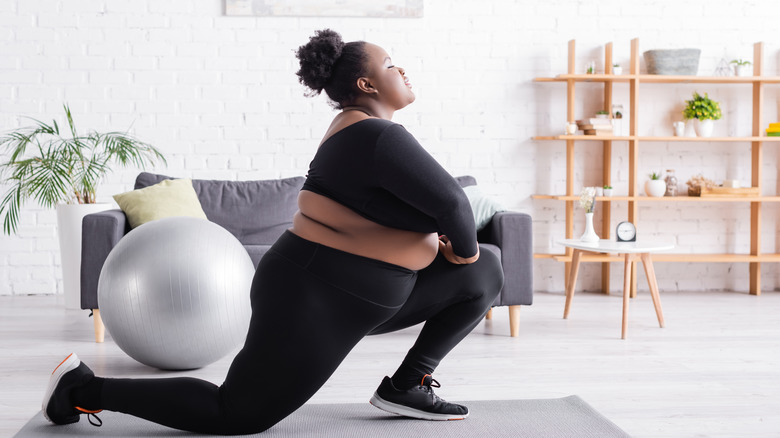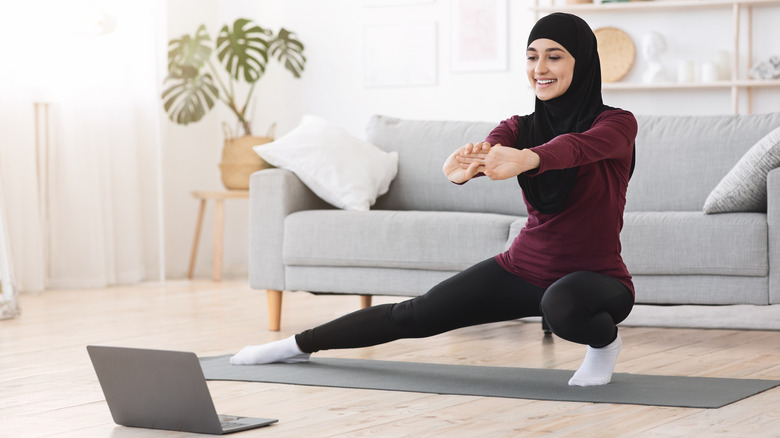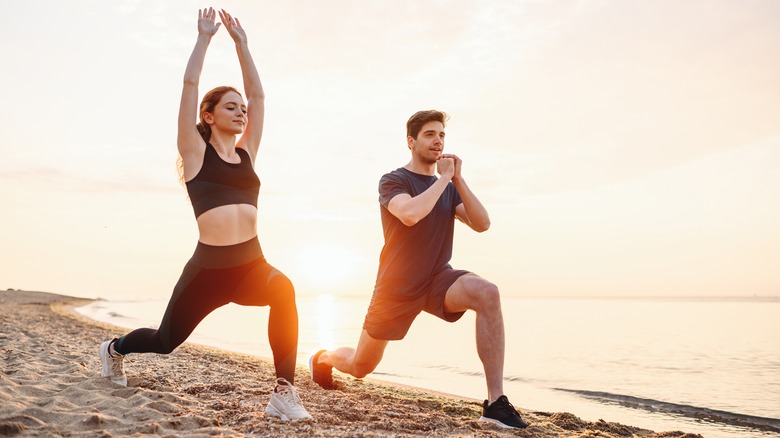What Muscles Are You Working When Doing Lunges?
Lunges get a lot of attention for their strength and health benefits. They're known for being a versatile strength training exercise, as both gym goers and at-home workout enthusiasts flock to add this exercise to their leg day routine. You may even find lunges being tossed into a warm-up or stretching routine. But which muscles do lunges target?
If you're adding lunges to your workout, this powerhouse compound movement targets several muscles to help stabilize, mobilize, and strengthen the body. In fact, lunges challenge the muscles concentrically (when they shorten) and eccentrically (when they lengthen) working both core muscles and leg muscles (via Healthline). The core muscles being targeted according to Healthline include the transverse abdominis, obliques, erector spinae, and the multifidus.
When it comes to the lower body, lunges work some major leg muscle groups. These include the gluteals, hamstrings, and calves (specifically the soleus and gastrocnemius). But most notably, the primary muscle that's being targeted is your quadricep muscles (aka the front part of your thigh), shares Livestrong. One 2020 study reported that during the eccentric phase the quadriceps, along with the glutes and hamstrings work together under tension to control the downward motion. But the quads manage and slow down the landing.
Which quad muscles are being worked?
According to Cleveland Clinic, the quad muscles are composed of five different segments. The first segment is the rectus femoris which spans from your hip bone down to your patella or kneecap. It's responsible for extending your knee and recruiting your hips while lowering during a lunge, points out Livestrong. Just beneath the rectus femoris is the vastus intermedius. Its primary function is to help with knee extension, and it's that middle muscle deep in your thigh.
The next quad muscle being worked is the vastus lateralis muscle. It's the largest muscle in the quadriceps group and it's found along the outside of the thigh (via Healthline). The job of the vastus lateralis is to support you when moving from a squatting position to standing and to help with extending the lower leg (similar to the other segments). The quad muscle located on the inside of the thigh is called the vastus medialis, and it's the smallest muscle of the bunch (per Cleveland Clinic). While its primary goal is to help with knee extension (just like the rest of the quad squad), the part of the vastus medialis that's located right above your knee also helps with stabilization, shares Livestrong.
But the newest discovered quadricep muscle is called the tensor of the vastus intermedius which lies between the vastus intermedius lateralis and vastus lateralis, according to Cleveland Clinic. Its function is still being researched.
What's better: forward, reverse, or walking lunges?
The lunge is great exercise for anyone looking to add compound exercises to their strength training routine. But as with many resistance exercises, there's several variations and they each may have slightly different benefits. Which, actually, can be confusing.
Forward lunges are the classic lunge. They're the staple across many lower body workout regimens since it's the beginning point for any lunge variation. Not only does it target the core muscles, but Women's Health shares forward lunges also improve hip flexibility, balance, and tones the glutes. To perform a forward lunch, place your feet hip-width apart. Step forward with your left foot and lower till both your knees are 90 degrees. Press into your left heel to stand up.
Believe it or not, reverse lunges are quite similar but instead of stepping forward, you step backward. "Ideally you should feel a stretch through the hamstring of the front leg," says certified personal trainer, Colleen Conlon, to Self.
For those looking to improve hamstring strength, walking lunges may be a great option. Findings from a study published in the Journal of Strength and Conditioning Research, indicates that walking lunges can improve hamstring strength, while jumping lunges increases running speed in young athletes. Similar to a forward lunge, a walking lunge starts the same. But instead, you'll want to push off each leg, then lunge (take a big step) with your back foot so now it's in the front lunge position (via Healthline).



